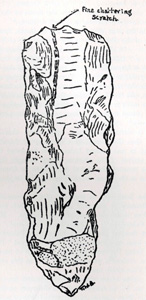Luton in the Middle Stone Age

Palaeolithic or Mesolithic implement found in New Bedford Road allotments
The Middle Stone Age, or Mesolithic, lasted from about 10,000 BC to about 4000 BC and was succeeded by the New Stone Age, or Neolithic. At this remote time, families of hunter gatherers roamed across the country, making brief stops before moving on. Given the shorter time span it is not surprising that finds from this era of human prehistory are much less common than those from the Palaeolithic in Luton.
The great Neolithic monument of Waulud's Bank also yielded a Mesolithic artefact, showing that the source of the River Lea was frequented from very ancient times, though such a stray find can tell us nothing about the nature of the inhabitation. Three Mesolithic flint cores and a flake were discovered in Leagrave and are now in Luton Museum, as recorded by the Bedfordshire Heritage Environment Record [HER9848] A tranchet axe was also found in New Bedford Road.
The other finds are uncertain in date. A quartzite pebble macehead with an hour-glass perforation found in Luton in 1897 may be of Mesolithic date [HER 182] and a stone pick found on an allotment off New Bedford Road in 1922 and reported by William Austin in his History of Luton of 1928 may have been either Palaeolithic or Mesolithic. The Bedfordshire Heritage Environment Record [HER9847] also records the find of an axe New Bedford Road at an unrecorded date.
The Bedfordshire Historic Environment Record records a number of recent Mesolithic finds in Luton. A mesolithic core and truncated blade were found by field walking at Great Bramingham Farm in the 1980s [HER15224]. Neolithic, Bronze Age and late Medieval artecafts were also found. Two Mesolithic blades, again with Neolithic, Bronze Age and Medieval artefacts were found west of Bradgers Hill in the 1980s [HER15227]. In the 1990s a flint axe or adze of the Mesolithic tranchet type was found in the garden of a house in Ashcroft Road [HER17777]